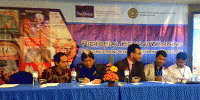
Can a least developed country set global precedence in public health? Yes, NEPAL!
(Image by CNS (Citizen News Service)) Details DMCA
(CNS): So said Mr Shanta Bahadur Shrestha, Secretary, Ministry of Health and Population, Nepal, in a recent interview given to CNS (Citizen News Service), during a workshop on 'Enforcement and Monitoring of Pictorial Health Warnings' organized by the International Union Against Tuberculosis and Lung Disease (The Union), in collaboration with School of Public Health, Udayana University, Bali, Indonesia.
There are 1.3 billion tobacco users in the world and over 6 million deaths every year due to tobacco use. Moreover 25% of the world's smokers and 90% of smokeless tobacco users live in the southeast Asia region.
Nepal is a developing country with a low income economy, ranking 145th of 187 countries on the Human Development Index in 2014. It continues to struggle with high levels of hunger and poverty. Despite these challenges, the country has been making steady progress, with the government making a commitment to graduate the nation from 'least developed country' status by 2022.
Small country makes big strides in tobacco control
Nepal, has recently taken a large step towards tobacco control. It is the first nation not only in the Southeast Asia region, but in the world, to have implemented a stringent legislation according to which 90% of the surface area of all tobacco packaging must be covered with pictorial health warnings (PHWs) - comprising text and visuals of harrowing images - designed to warn consumers of the health consequences of tobacco use. This regulation has been implemented since May 2015. The country has other stringent tobacco control measures in place too, like ban on smoking in public places, work places, public transport, as well as at home and private cars in the presence of another person; complete ban on tobacco advertising, promotion and sponsorship (TAPS); ban on sale and distribution of tobacco products by minors and pregnant women; ban on free distribution of tobacco products; and ban on sale of cigarette packs with less than 20 sticks. Production and sale of e-cigarettes is also banned in Nepal.
All this has resulted in a decrease in smoking rates in Nepalese adults from 26% in 2007 to 18% in 2013, even though smokeless tobacco use has remained almost static at around 18%.
Challenging to protect youth from tobacco in Nepal
However Shrestha is worried that, despite all these strict tobacco control measures, tobacco use in Nepalese youth is on the rise. It has more than doubled--from 9.4% in 2007 to 20.4% in 2011. In the case of girls this increase has been more than threefold. Controlling tobacco use in young people is indeed posing a big challenge in Nepal.
(Note: You can view every article as one long page if you sign up as an Advocate Member, or higher).





